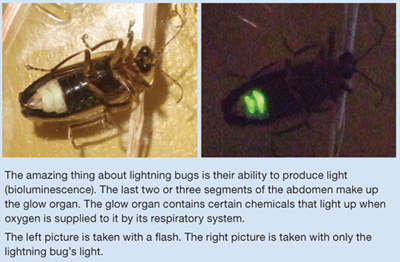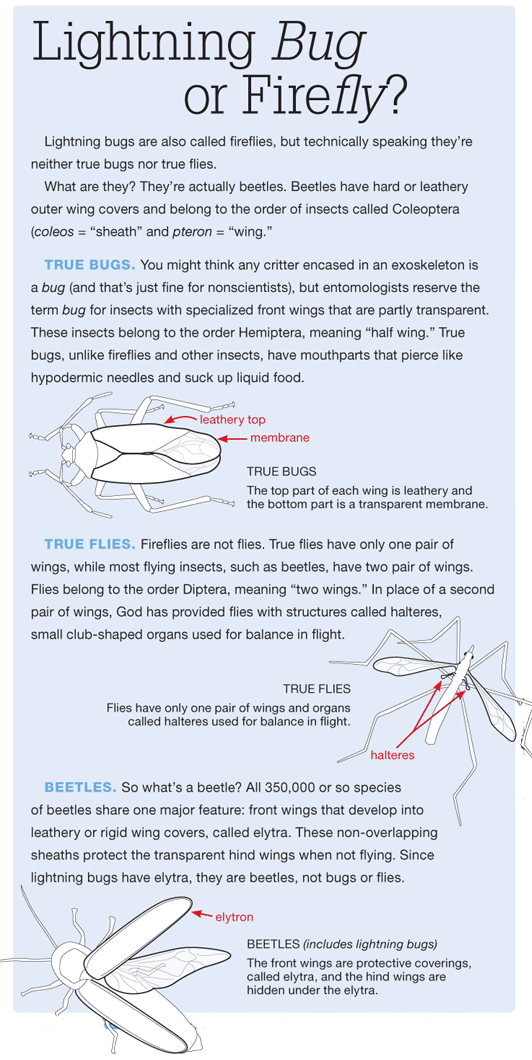Lightning Bugs: The Beetle Beacons
The most amazing thing about lightning bugs, of course, is their ability to produce light. What mechanism performs this magic?
If you ever lived in the eastern United States, you probably witnessed one of those magical light shows that bedazzle on summer nights. As darkness settles over the creeks and woodlots, tiny pinpricks of yellow or green light begin blinking in beautiful randomness. Anyone who grows up watching these magical displays cherishes this childhood memory.
I grew up in Annapolis, Maryland, near such a woodlot. I remember my excitement as I lunged about in the darkness trying to catch one of the sources of those eerie Lilliputian beacons. Seeing my delight when I succeeded, you’d think I had caught a fairy waving her glowing wand.
No, it was something much more exciting. Instead of something familiar, like the human form of Tinkerbell, I had captured a bizarre little alien.
It had a concealed head with large compound eyes. Strange segmented antennae waved about close by. Six legs protruded from its body. On its back were two transparent wings, protected by two leathery wing covers. And what’s this? A hind end that actually glows in the dark!
This creature was just as incredible as the biblical cherubim, only a lot smaller—it was a lightning bug! Here in my hand, light was radiating from a creature crafted by the Word of God, the Lord Jesus Christ Himself. Of course I should be awestruck.
How Does a Beetle Bum Become a Beacon?

The most amazing thing about lightning bugs, of course, is their ability to produce light (bioluminescence), which they switch on and off at will. So what mechanism performs this magic? The last two or three segments of the abdomen make up the glow organ. Here, underneath the exoskeleton, are specialized cells called photocytes (light cells).
These light cells need several ingredients to make light. One is a chemical called luciferin (remember Lucifer, who was the “angel of light”). A second ingredient, called luciferase, causes the luciferin to break down and produce light. A third ingredient is the common molecule ATP (adenosine triphosphate), which provides the energy to drive the chemical reaction.
These ingredients are always present in a glow organ. So why isn’t it constantly glowing? How does the firefly turn off its light? The last ingredient is oxygen. The chemical reaction can’t take place without oxygen. No oxygen; no reaction; no light.
One widely held theory of how the firefly turns its light off is that it simply shuts off the oxygen supply (oxygen control theory). Whenever the insect needs the light to glow again, it feeds oxygen to the glow organ, and—voilá—the reaction begins again.
Another amazing feature is that the light cells are just beneath a transparent exoskeleton so that the light can freely shine from the abdomen. No sense in hiding your light under a bushel.
A Beetle Went a Courtin’. . .
So the next logical question is why an insect would need its bottom to glow in the dark in the first place. Although it has been shown that firefly glow organs warn predators that they taste bad, the main purpose that entomologists have discovered is that the light serves as a homing beacon for potential mates.
The main purpose of the light produced by fireflies is to serve as a homing beacon to attract potential mates.
Some species display a unique flash pattern. Like using Morse code, the flying males send out signals beckoning females of the same species who will respond with a corresponding flash pattern, which says, “I’m over here, sweetheart.” When a male sees her flirtatious flickering response, he heads straight toward her, flashing as he goes, as if to say, “Keep flashing, my love; your knight in shining armor will be there shortly” (literally shining armor, for his exoskeleton is aglow).
The female usually stays put while the male flies toward her. They keep flashing back and forth as they get closer to each other. Once he arrives, they mate. After her eggs are fertilized, she proceeds to lay them in the leaf litter.
Beacon of Death
Order: Coleoptera (beetles)
Family: Lampyridae (lightning bugs)
Genus/Species: Over 1,700 species worldwide; approximately 125 are native to the United States and Canada.
Length: 5 to 20 mm
Diet: Some adults and all larvae are predators, eating snails, slugs, and other small, soft invertebrates.
Habitat: Tropical rainforests and moist areas in temperate deciduous woodlands.
Attracting a mate is amazing enough, but that’s not all fireflies use their lights for. The females of one notable firefly genus (Photuris) lure males of a different genus (typically Photinus) by mimicking the Photinus flash pattern.
Attracted by the courtship signal of his own species, the duped male flies toward the Photuris female seeking to mate. Upon his arrival the female devours him. Instead of fertilizing eggs of his own species, he becomes a meal that provides her with the nourishment she needs to make her own eggs.
Lightning bugs are truly fantastical insects, even with their ability to produce light for morbid ends. Fascinating as this strange predatory behavior is, we should be mindful that the world was much different prior to Adam’s Fall. Animals with nephesh (Hebrew for “life”) didn’t devour each other, and this may have included insects (Genesis 1:30). If so, fireflies originally may have consumed plants or gotten sustenance from photosynthetic algae embedded in their tissues.
Many examples of non-predators exist today. They give us a glimpse of what it may have been like in Eden before Adam’s Fall and what it may be like in the new heavens and new earth. All creation groans now, but some day that will change.

Answers Magazine
April – June 2009
Spring vacations and summer trips require a little advanced planning. It’s not too soon to start thinking about that much-needed family getaway. Vacations help relieve stress, bond families, and create lasting memories. But they can also provide learning opportunities that draw us closer to our Creator. Get tips for ten vacation destinations that will help build your family’s biblical worldview, in a way they’ll never forget!
Browse Issue
Answers in Genesis is an apologetics ministry, dedicated to helping Christians defend their faith and proclaim the good news of Jesus Christ.
- Customer Service 800.778.3390
- Available Monday–Friday | 9 AM–5 PM ET
- © 2025 Answers in Genesis


